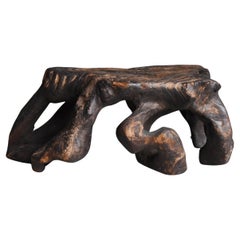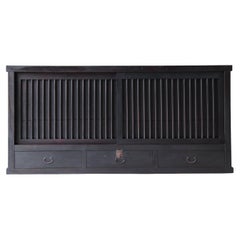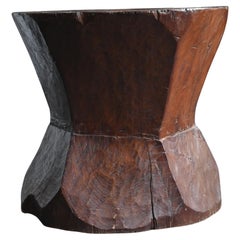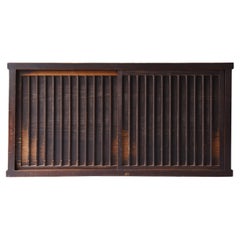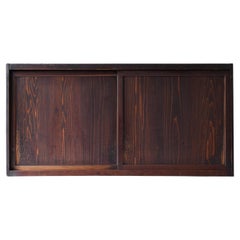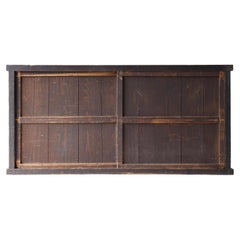Japan
to
454
993,404
707,005
2,154
1,618
793
556
437
422
341
181
140
119
108
93
92
81
62
54
47
46
46
41
25
22
13
12
10
9
7
7
6
6
6
5
5
4
4
3
3
2
2
2
1
1
1
1
1
1
1
1
301
201
70
66
44
Japanese Antique Primitive Side Chair 1900s-1940s / Display Stand Wabi Sabi
Located in Chōsei District Nagara, JP
This is an old Japanese primitive-style stool or stand, believed to have been crafted in the early Showa period (1900s–1940s). The material appears to be kiri (paulownia wood), known...
Category
Mid-20th Century Japanese Primitive Japan
Materials
Wood
Japanese Antique Large Black Tansu 1860s-1900s / Cabinet Sideboard Wabisabi
Located in Chōsei District Nagara, JP
This is a large, old Japanese tansu chest, made in the Meiji period (1860s–1900s).
Crafted from traditional Japanese cedar, this piece embodies the daily life and craftsmanship of th...
Category
Early 20th Century Japanese Meiji Japan
Materials
Iron
Old Japanese Wooden Stool / 20th Century / Polygonal Chair/MINGEI
Located in Sammu-shi, Chiba
This stool is crafted from vintage Japanese zelkova wood. Originally used as a mortar, the top was later cut horizontally and reworked to transform it into a practical stool. It's be...
Category
20th Century Japanese Showa Japan
Materials
Wood
Japanese Antique Large Brown Tansu 1860s-1900s / Sideboard Cabinet Wabisabi
Located in Chōsei District Nagara, JP
This is a large antique brown Tansu chest from Japan. While black lacquered finishes are more common, a Tansu with this warm brown tone is highly unusual and therefore particularly r...
Category
Early 20th Century Japanese Meiji Japan
Materials
Cedar
Japanese Antique Large Tansu 1860s-1900s / Sideboard Cabinet Storage Wabi Sabi
Located in Chōsei District Nagara, JP
This is a large antique Tansu chest from Japan, crafted during the Meiji period (1860s–1900s). It is made of Japanese cedar, whose surface has gained depth and character over time, c...
Category
Early 20th Century Japanese Meiji Japan
Materials
Cedar
Japanese Antique Large Tansu 1860s-1900s / Storage Cabinet Sideboard Wabisabi
Located in Chōsei District Nagara, JP
This is a large antique Tansu chest from Japan, crafted during the Meiji period (1860s–1900s). Made with Japanese cedar and finished with great care, it has endured for over a centur...
Category
Early 20th Century Japanese Meiji Japan
Materials
Cedar
Japanese Antique Wabi-Sabi Low Table Edo period 1800s-1860s / Side Table
Located in Chōsei District Nagara, JP
This is an old Japanese low table, crafted during the Edo period (1800s–1860s). It is a rare piece of furniture that has survived through the centuries to the present day. Made of su...
Category
Mid-19th Century Japanese Edo Antique Japan
Materials
Cedar
Japanese Antique Primitive Stool - Carved from One Solid Block / Wabisabi
By Axel Vervoordt
Located in Chōsei District Nagara, JP
This is an old Japanese primitive-style stool, crafted during the Meiji period (1860s–1900s).
It exudes a simple yet powerful presence. The material is robust chestnut wood, and wha...
Category
Early 20th Century Japanese Primitive Japan
Materials
Chestnut
Old Japanese wooden display stand and stool / 20th century/Wabi-sabi object
Located in Sammu-shi, Chiba
This wooden display stand/stool was made in Japan around the 20th century. It's believed to be made from solid, solid zelkova (keyaki) wood, exuding a strong grain and sturdy texture...
Category
20th Century Japanese Showa Japan
Materials
Other
Japanese Antique Wabi Sabi Low Table 1860s-1900s / Primitive Sofa Table Mingei
By Axel Vervoordt
Located in Chōsei District Nagara, JP
This is an antique Japanese low table featuring a separate top and base, allowing for easy movement and placement. It is believed to have been crafted in the Meiji period (1860s–1900...
Category
Early 20th Century Japanese Primitive Japan
Materials
Cedar
Vintage Malatya Chuval Kilim Cuval Rug Nomadic Anatolian Natural Turkish Carpet
Located in Tokyo, JP
This is a beautifully detailed old Malatya Region, Anatolian Chuval kilim, featuring a bold, three-dimensional texture and precise geometric patterns. Originally used by nomadic trib...
Category
Mid-20th Century Turkish Kilim Japan
Materials
Wool, Natural Fiber, Organic Material
$520 Sale Price
20% Off
Japanese Old Concrete Sphere Sculpture 1950s-1970s / Object Wabi Sabi
By Axel Vervoordt
Located in Chōsei District Nagara, JP
This is an old Japanese concrete sphere, admired for the unique character it has acquired after decades of exposure to the elements. Its surface is lightly covered with moss, accente...
Category
Late 20th Century Japanese Showa Japan
Materials
Concrete
Vintage Japanese wooden ptarmigan figurine / Made in 1967 / Showa era
Located in Sammu-shi, Chiba
This wooden ptarmigan statue was carved in Japan in 1967 (Showa 42). The underside of the base is inscribed with ink: "April 1967," "Ptarmigan," and "Living on Mount Tateyama," revea...
Category
1960s Japanese Showa Vintage Japan
Materials
Wood
Antique Khamseh Wool Rug with Birds and Geometric Motifs Tribal Natural Carpet
Located in Tokyo, JP
This striking antique Khamseh rug, handwoven in southern Iran during the late 19th to early 20th century, captures the spirit and vitality of Qashqai tribal artistry. Measuring 133 c...
Category
Early 20th Century Turkish Oushak Japan
Materials
Wool, Natural Fiber, Organic Material
Japanese Antique Tansu 1860s-1900s / Sideboard Wabi Sabi #02
Located in Sammu-shi, Chiba
This is a historically significant Japanese Tansu cabinet, crafted from cedar wood during the Meiji period (1860s–1900s).
Its minimalist and refined design embodies traditional Japanese aesthetics, bringing a sense of understated elegance and serene presence to any interior. Over time, the cedar wood has developed a warm, rich patina, enhancing the cabinet’s unique character and depth.
A distinctive feature of this piece is the lattice at the upper back, designed to provide ventilation.
The sliding doors operate smoothly, and the piece has been carefully cleaned and disinfected, ready for immediate use. Its condition is excellent considering its age.
This Tansu reflects the philosophy of *wabi-sabi*, finding beauty in imperfection and impermanence. Its understated elegance contrasts with conventional opulence, making it a rare and distinctive work of craftsmanship.
Additionally, this cabinet can be paired and stacked with the Japanese Antique Tansu...
Category
Late 19th Century Japanese Meiji Antique Japan
Materials
Cedar
Japanese Antique Cedar Wood Board Wall Decoration 1860s-1900s / Wabi Sabi
By Axel Vervoordt
Located in Chōsei District Nagara, JP
This is an old, single-slab board made of Japanese cedar, believed to date back to the Meiji period (1860s–1900s). Cut from the trunk of a large, centuries-old cedar tree, it retains...
Category
Late 19th Century Japanese Primitive Antique Japan
Materials
Cedar
Japanese Antique Crucible 1900s-1920s / Flower Vase Wabi Sabi
By Axel Vervoordt
Located in Chōsei District Nagara, JP
This is an old Japanese crucible, believed to have been used during the Meiji to Taisho period (1860s–1920s).
Crucibles like this were essential tools in metal refining and casting, ...
Category
Early 1900s Japanese Meiji Antique Japan
Materials
Clay
Japanese Old Iron Block 1950s-1970s / Display stand Wabi Sabi
Located in Chōsei District Nagara, JP
This is an old Japanese iron block, estimated to have been made in the early Showa period (1950s–1970s). At the time, it was used in ironworks as an anvil or workbench. Decades of us...
Category
Late 20th Century Japanese Showa Japan
Materials
Iron
Japanese Antique "BORO" 1800s-1860s / Rag Tapestry Patchwork Textile Wabisabi
Located in Chōsei District Nagara, JP
This is an old Japanese BORO, dating back to the late Edo period (1800s–1860s). It is an extremely valuable textile that has been carefully preserved and passed down to the present d...
Category
Mid-19th Century Japanese Edo Antique Japan
Materials
Fabric
Japanese Antique Large Tansu / Cabinet Sideboard / 1868-1912s Wabi-sabi
Located in Iwate-gun Shizukuishi-cho, Iwate Prefecture
This is an old Japanese tansu.
It was used around the Meiji period and is made primarily of cedar.
The naturally peeling paint on the front expresses a natural beauty that could no...
Category
Late 19th Century Japanese Meiji Antique Japan
Materials
Iron
Antique Konya Kilim Rug Wool Geometric Central Anatolian Old Turkish Carpet
Located in Tokyo, JP
This is Central Anatolian Antique Kilim from the Konya region with a rare and beautiful muted color composition.
This highly collectible antique kilim has wonderful, special colors ...
Category
Early 20th Century Turkish Kilim Japan
Materials
Wool, Natural Fiber
African Senufo bed/20th century/low table
Located in Sammu-shi, Chiba
This is an ancient wooden bed made by the Senufo people, who live in the area around Côte d'Ivoire and Mali in West Africa. The Senufo are known for their unique carving culture and ...
Category
20th Century Malian Other Japan
Materials
Wool
Japanese Vintage Glass Sliding-Door Cabinet, Early Showa Period (1926–)
Located in Hitachiomiya-shi, 08
This vintage cabinet was crafted in the Early Showa Period (1926–).
Made from Japanese cedar with a black finish, the surface shows a gently lived-in patina that lends quiet wabi-sa...
Category
Mid-20th Century Japanese Showa Japan
Materials
Cedar
Ararat Rugs Safavid Kirman Vase Technique Carpet Kerman Revival Rug Natural Dyed
By Ararat Rugs
Located in Tokyo, JP
Discover an exquisite, rare Safavid Kirman 'Vase-Technique' Carpet, handwoven in Eastern Turkiye. This splendid carpet is laid out with a floral design of surprising complexity, agai...
Category
21st Century and Contemporary Turkish Revival Japan
Materials
Wool, Natural Fiber, Organic Material
Antique Japanese wooden coffee table /Early 20th Century / Wabi-sabi sofa table
Located in Sammu-shi, Chiba
This low table combines a traditional Japanese wooden top and legs. The top is crafted from a single piece of luxurious cedar, enveloping the entire piece with its soft, warm grain. ...
Category
Early 20th Century Japanese Taisho Japan
Materials
Cedar
Japanese Antique Cabinet with Glass Doors, Taisho Era (1912–1926), Wabi Sabi
Located in Hitachiomiya-shi, 08
This antique cabinet was crafted in the Taisho Era (1912–1926).
Made from Japanese cedar, this piece features a warm and inviting texture that has deepened over time, adding to its ...
Category
Early 20th Century Japanese Taisho Japan
Materials
Cedar
Japanese Antique Small Drawer 1860s-1900s / Nightstand Tansu Wabi Sabi
Located in Chōsei District Nagara, JP
This is an old small drawer storage made in Japan. The furniture was made during the Meiji period (1860s-1900s), and the texture of the wood over the years gives it a deep flavor. Th...
Category
Early 20th Century Japanese Meiji Japan
Materials
Iron
Japanese Antique Rag "BORO" 1800s-1860s / Abstract Art Wabi Sabi
Located in Sammu-shi, Chiba
This is an exceptional example of a Japanese *BORO* textile, dating from the late Edo period (1800s–1860s). Carefully preserved over generations, it embodies both the resourcefulness...
Category
Mid-19th Century Japanese Edo Antique Japan
Materials
Fabric
Japanese Antique Large Tansu 1860s-1900s / Cabinet Cupboard Wabi Sabi
Located in Chōsei District Nagara, JP
This is an old, large Tansu made in Japan. It is an unusual style with a vertical structure, and is thought to have been made during the Meiji period (1860s-1900s). Unlike most horiz...
Category
Early 20th Century Japanese Meiji Japan
Materials
Cedar
Antique Japanese wooden coffee table / 1868-1920 / sofa table / display stand
Located in Sammu-shi, Chiba
This wooden low table, known as a fuzukue (writing desk), was made in Japan between the late Edo and Meiji periods (circa 1868-1920). A writing desk is a traditional Japanese piece of furniture, originally a small desk used while sitting on a tatami mat. While primarily used as a practical tool for writing, reading, and writing letters, its dignified presence has led to its current popularity as a decorative table and low table.
This writing desk is crafted from Japanese zelkova (keyaki) wood. Zelkova is a precious wood that has long been beloved by the Japanese people and is known for its use in shrine and temple construction. Due to its solid, hard wood with particularly beautiful grain, it is often used for luxury furniture and crafts. The tabletop features the beautiful annual ring pattern, known as "bamboo shoot grain," characteristic of zelkova. Combined with the rich texture borne over time, this wood exudes a quiet, engaging charm.
The tabletop is carved from a single piece of wood and shows slight warping, but is generally in very good condition. The legs are simple and sturdy, indicating they have withstood years of use. There's no wobble, making it safe to use in modern living spaces.
At just 23cm high, it's perfect for pairing with a sofa or zaisu chair...
Category
Late 19th Century Japanese Meiji Antique Japan
Materials
Wood
Simple antique Japanese wooden drawer / 1868-1920 / Meiji-Taisho period
Located in Sammu-shi, Chiba
This is an old Japanese wooden drawer, likely made between 1868 and 1920, during the Meiji and Taisho periods. Crafted from light and warm cedar, the entire piece is crafted from ced...
Category
Late 19th Century Japanese Meiji Antique Japan
Materials
Cedar
Japanese Antique Large Black Tansu / Cabinet Sideboard / 1868-1912s Wabi-sabi
Located in Iwate-gun Shizukuishi-cho, Iwate Prefecture
This is an old Japanese tansu.
It was used in the Tohoku region around the Meiji period and is made primarily of cedar.
The four large drawers are an unusual size and have chestnut...
Category
Late 19th Century Japanese Meiji Antique Japan
Materials
Iron
Japanese Vintage Cabinet with Diamond Glass Sliding Doors, Early Showa (1926–)
Located in Hitachiomiya-shi, 08
This vintage cabinet was crafted in the Early Showa Period (1926–).
Compact in size and built primarily in Japanese Sen wood. The sliding doors pair keyaki (zelkova) paneling with d...
Category
Mid-20th Century Japanese Showa Japan
Materials
Wood
Ararat Rugs Oversized Mamlouk Rug A Majestic Revival of Islamic Artistry Carpet
By Ararat Rugs
Located in Tokyo, JP
Origin and Inspiration:
The Mamlouk Rug is a contemporary masterpiece that draws its inspiration from the rich textile traditions of the Mamlouk Sultanate, which reigned over Egypt a...
Category
21st Century and Contemporary Turkish Revival Japan
Materials
Wool, Natural Fiber, Organic Material
Old Japanese bamboo woven flower vase / Japanese-style object / 20th century
Located in Sammu-shi, Chiba
This antique bamboo vase reflects the traditional beauty of Japan.
With a diameter of 23cm, a height of 15.4cm, and a weight of just 0.5kg, it's easy to handle and will subtly add co...
Category
20th Century Japanese Taisho Japan
Materials
Bamboo
Japanese Antique Paper Wabi-Sabi Washi
Located in Sammu-shi, Chiba
This rare shichou-maku (paper-hung curtain) was crafted during Japan’s Meiji period (late 19th to early 20th century).
It was originally used in sericulture rooms—spaces dedicated ...
Category
Early 19th Century Japanese Edo Antique Japan
Materials
Paper
Antique Japanese wooden Hokkaido Ainu tray / early 20th century/MINGEI
Located in Sammu-shi, Chiba
We'd like to introduce a rare item to you. This is an "ita tray," a traditional wooden tray used by the Ainu people, crafted in Hokkaido. It likely dates from the Taisho to early Sho...
Category
Early 20th Century Japanese Taisho Japan
Materials
Wood
Japanese Antique Primitive Low Table 1860s-1920s / Wabi Sabi
Located in Sammu-shi, Chiba
This is a very old low table made in Japan.
Its design is simple—consisting of a single slab of wood placed atop a tree stump.
The materials used for both the top and base date back ...
Category
Early 20th Century Japanese Meiji Japan
Materials
Chestnut
Antique Japanese wooden lattice chair / 1868-1920 / Simple and rustic stool
Located in Sammu-shi, Chiba
This is an old wooden chair believed to have been made between the Meiji and Taisho periods, or perhaps the early Showa period. Its simple yet distinctive design is eye-catching, evo...
Category
Late 19th Century Japanese Meiji Antique Japan
Materials
Oak
Japanese small Black Tansu 1900-1940 / Taisho Period/Cabinet Sideboard Wabisabi
Located in Sammu-shi, Chiba
This is a historically significant Japanese tansu made between the Taisho period and the early Showa period (1910s–1920s).
It is crafted from Japanese cedar wood.
Its minimalist and...
Category
Early 20th Century Japanese Taisho Japan
Materials
Cedar
Japanese antique wooden work board / Wabi sabi / Display stand / Side table
Located in Sammu-shi, Chiba
This is an old Japanese workbench made from zelkova wood (keyaki),
known for its strength and beautifully distinct grain.
The thick cross-section c...
Category
20th Century Japanese Taisho Japan
Materials
Wood
0.19 Carat Brazilian Alexandrite and Diamond Ring Made in Platinum
Located in Tokyo, JP
A gorgeous ring featuring a 0.19 Carats Natural Brazilian Alexandrite and 0.29 Carats of Diamond Accents made in Platinum. Alexandrites produce a natural color-change phenomenon as t...
Category
21st Century and Contemporary Japanese Modern Japan
Materials
Alexandrite, Diamond, Platinum
3.98 Carat Natural 'AAA' Tanzanite and Diamond Ring Made in Platinum
Located in Tokyo, JP
A beautiful ring featuring a 3.98 Carat Natural Tanzanite and 1.94 Carat Diamonds Made in Platinum. Tanzanite's name was given by Tiffany and Co after its only known source: Tanzania...
Category
21st Century and Contemporary Japanese Modern Japan
Materials
Diamond, Tanzanite, Platinum
Japanese Antique Cabinet 1860s-1920s / Tansu Sideboard Wabisabi
Located in Chōsei District Nagara, JP
This is an old storage cabinet made in Japan.
It is a piece of furniture made between the Meiji and Taisho periods (1860s-1920s), and it is a piece of furniture that has passed throu...
Category
Early 20th Century Japanese Taisho Japan
Materials
Iron
Japanese Antique Chest of Drawers 1860s-1900s / Tansu Nightstand Wabi Sabi
Located in Chōsei District Nagara, JP
This is an old drawer storage made in Japan.
This furniture was made during the Meiji period (1860s-1900s) and is a valuable piece of furniture that has transcended time and remains ...
Category
Early 20th Century Japanese Meiji Japan
Materials
Iron
Portrait of a Lady Japanese Vintage Oil Painting by Yoshito Shibata
Located in Chiba, JP
Vintage oil painting on wooden plate, by a Japanese painter, Yoshito Shibata (1910-1995), circa 1960-70s, 24 x 33.3 x 0.5 cm (9.44 x 13.11 x 0.19in)
Category
1960s Japanese Showa Vintage Japan
Materials
Wood
Japanese Antique Cabinet with Glass Doors, Taisho Era (1912–1926), Wabi-Sabi
Located in Hitachiomiya-shi, 08
This antique cabinet with glass sliding doors was crafted in the Taisho Era (1912–1926).
Built in Japanese cherry and cedar with persimmon-wood drawer fronts, and finished in tradit...
Category
Early 20th Century Japanese Taisho Japan
Materials
Wood, Cherry, Cedar
Japanese Antique Black Box / Side Table Exhibition Stand / 1868-1912s/ Wabi-sabi
Located in Iwate-gun Shizukuishi-cho, Iwate Prefecture
This is an old wooden storage box made in Japan.
It is thought to date from around the Meiji period and is made of cedar.
It has a simple design with no metal fittings.
The overall m...
Category
Late 19th Century Japanese Meiji Antique Japan
Materials
Wood, Cedar
Japanese Antique Artillery Shell 1900s-1920s / Iron Ball Object Wabisabi
Located in Chōsei District Nagara, JP
This is an old Japanese artillery shell.
From its appearance, it is assumed that it is an iron shell for artillery.
Considering the size, shape, and rusty condition of this iron ball...
Category
1910s Japanese Showa Vintage Japan
Materials
Iron
Japanese Antique Black Drawer Storage 1860s-1900s / Tansu Sideboard Wabisabi
Located in Chōsei District Nagara, JP
This is an old drawer storage made in Japan.
It was made during the Meiji period (1860s-1900s) and is a valuable antique piece of furniture filled with Japanese craftsmanship. The ma...
Category
Early 20th Century Japanese Meiji Japan
Materials
Iron
1984 Japanese Vintage Watercolor Fish Painting
Located in Chiba, JP
Large vintage watercolor painting on hard paper, 108 x 76.5 cm (42.51 x 30.11in), titled ‘Codfish’ by a Japanese painter, Komata Yoshio (Arakawa-ku, Tokyo), February, 1984. Some cre...
Category
1980s Japanese Showa Vintage Japan
Materials
Paper
Japanese Antique Stone Carving Penis 1800s-1860s / Sculpture Wabi Sabi Mingei
Located in Chōsei District Nagara, JP
This is an old Japanese stone carving of a phallus, believed to have been made in the late Edo period (1800s–1860s). It is a rare and valuable a...
Category
Late 19th Century Japanese Edo Antique Japan
Materials
Stone
Japanese antique Bizen ware vase / 15th-16th century / Wabi-sabi vase/Tsubo
Located in Sammu-shi, Chiba
This Bizen ware jar was fired in the Bizen region of Okayama Prefecture. Bizen ware is one of Japan's Six Ancient Kilns and is known as one of the oldest pottery styles in Japan. Its...
Category
16th Century Japanese Other Antique Japan
Materials
Pottery
Japanese Antique Huge Wooden Bowl 1906s / Primitive Object Wabisabi Mingei
Located in Chōsei District Nagara, JP
This is a huge old Japanese lacquer wood bowl.
It was manufactured in 1906 (Meiji period), and its age can be read from the writing on the bottom. The material used is cedar wood, ma...
Category
Early 1900s Japanese Meiji Antique Japan
Materials
Cedar, Lacquer
Japanese Antique Large Black Sideboard 1860s-1900s / Tansu Wabisabi
Located in Chōsei District Nagara, JP
This is an old, large sideboard made in Japan.
The furniture was made during the Meiji period (1860s-1900s) and has a deep black paint throughout, giving it a stately appearance.
The...
Category
Early 20th Century Japanese Meiji Japan
Materials
Iron
Antique Korean Stone Pot / Joseon Dynasty / Stone Folk Art Object
Located in Sammu-shi, Chiba
This stone pot was made in Korea during the late Joseon dynasty, between the late 19th and early 20th centuries. Its sturdy appearance, carved from a granite-like stone, emanates a p...
Category
Late 19th Century Japanese Other Antique Japan
Materials
Stone
Kaj Franck / KF2 HORS D'OEUVRE DISH(BROWN) / Arabia Finland
By Arabia of Finland, Kaj Franck
Located in Shibuya-Ku, JP
KF2 was designed in 1957 and manufactured from 1958 to 1962.
A geometric-shaped appetiser dish. One of Kai Franck's masterpieces, combining structural beauty with functional elegance...
Category
1950s Finnish Scandinavian Modern Vintage Japan
Materials
Ceramic
Japanese Old Primitive Side Chair 1950s-1970s / Wabi Sabi
Located in Chōsei District Nagara, JP
This is an old side chair made in Japan.
It was made in the postwar period (1950s-1970s), and the material used is cedar wood with a rustic look.
The structure, carved in one piece ...
Category
Late 20th Century Japanese Primitive Japan
Materials
Cedar
F.171201 by Toshio Iezumi - Contemporary glass sculpture, green, abstract, light
By Toshio Iezumi
Located in Paris, FR
F.171201 is a glass sculpture by Japanese contemporary artist Toshio Iezumi, dimensions are 17 × 42 × 35 cm (6.7 × 16.5 × 13.8 in).
The sculpture is signed and numbered, it is part ...
Category
2010s Contemporary Japan
Materials
Glass
New Manisa Fine Handwoven Modern Kilim West Anatolian Rug Turkish Wool Carpet
Located in Tokyo, JP
This is a Western Anatolian Modern 'New' Fine Kilim from the Manisa region with a rare and beautiful color composition.
This kilim is woven according to traditional kilim technique...
Category
2010s Turkish Kilim Japan
Materials
Wool, Natural Fiber
$648 Sale Price
20% Off
